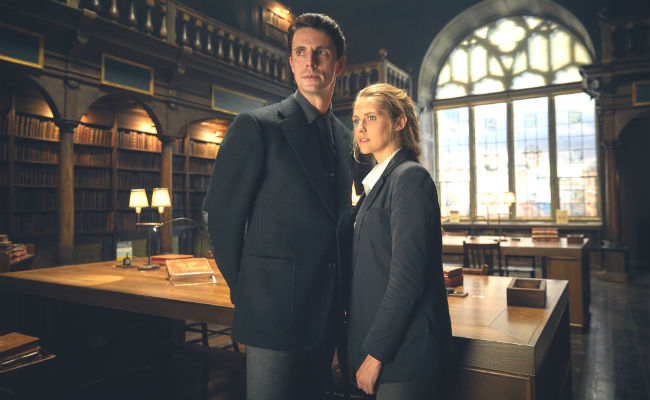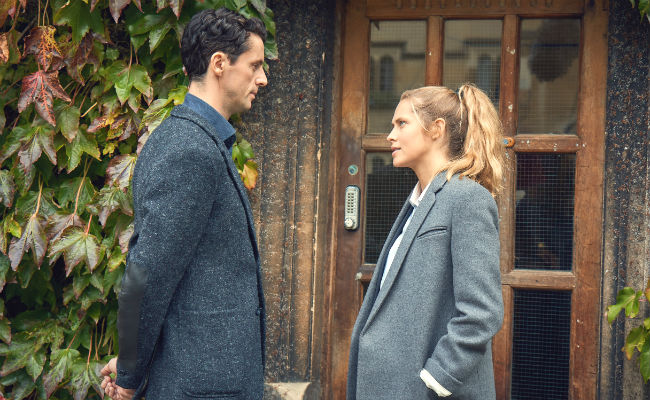
The simplest way to describe Sundance Now’s latest fantasy epic, A Discovery of Witches, is to dub it a Harry–Potter-meets-Twilight crossover for adults.
The headline practically writes itself and it’s the kind of slug that would bait all the clicks on Twitter. The temptation to write the show off as fanfiction for romantically-starved genre-lovers is even harder to deny when you’re looking at the bare-bones of this new series. An Oxford-studying witch, reluctant to use her seemingly limitless abilities, meets a mysterious, otherworldly vampire. Sparks fly, blood cravings follow – it’s the catnip guaranteed to hook disciples of J.K. Rowling and Stephanie Meyers who have aged enough to be turned off by teenage angst and high school woes. But I’m going to forgo the easy route with this review and instead, give A Discovery of Witches its rightful due.
This show is not Harry–Potter-meets-Twilight despite hints of magical prophecies, forbidden interspecies romances and plenty of screen time for historic English libraries and lovely Venetian canals (I could spend this entire review gushing about the lush cinematography and predicting a rise in “French castle” bookings on Airbnb), though it occasionally trades in some of the same tropes.
For instance, the series’ main character is a young witch named Diana Bishop (Teresa Palmer) a woman completely unaware of the scope of her powers, thrust into a foreign world of creatures mere humans believe to be folklore, after happening upon an ancient tome that’s been missing for centuries and might just hold the key to the creation of life itself. Diana’s content to bike around her idyllic Oxford campus, shuffle to the picturesque Bodleian library spending hours combing the racks for works on alchemy and the melding of magic and science. She enjoys a pint at the pub, a row on the river, and has absolutely no interest in testing her magical abilities. Her parents were murdered for being powerful witches and that kind of trauma really leaves a mark.
Of course, Diana is a rather passive character in her own life for most of the show’s first season, which means, whether she wills it or not, magic eventually comes knocking and it comes knocking in the form of a book believed to have disappeared hundreds of years ago. Witches, vampires, demons, they’ve all been searching for it, hoping it might explain why their respective species seem to be dying out. Diana’s ability to call the book from the stacks of the Bodleian, seemingly at will, attracts one such creature, a thousand-year-old vampire named Matthew Clairmont (Matthew Goode).
He’s a geneticist, a professor at the university, one who’s drawn to Diana not just because of the book but because of her powers and their undeniable chemistry. The romance between the two, more than the supernatural happenings, is what feels most worthy of that Twilight comparison. There’s the expected push-and-pull, the will-they-won’t-they, although we all know they most certainly will.
I’ve no doubt Goode spawned the origin of the phrase “tall, dark, and handsome” and he puts in a worthy performance as a world-weary immortal struggling against his own nature and his desire for a woman who is, by all accounts, off limits. It’s no easy task to growl, snarl, and grimace your way through loaded love scenes but the guy’s got an inherent charisma that forces us to forget his character’s darker nature.
Palmer too delivers the kind of bushy-haired, wide-eyed act expected of a woman unearthing long-buried secrets of an underworld she’s been ignorant of for most of her life. She carries the burden of selling this story with ease, flitting between awe and anger, confusion, despair, lust, and intrigue with an earnestness and charm that demands trust from us, the viewers. And the pair has an electric sort of chemistry, an obvious rapport that makes moments when Matthew issues thinly-veiled threats and challenges Diana to accept her true nature much more charged than the pared-down script might intend.

But the show elevates itself from its genre predecessors in unexpected ways.
For one, it’s obviously not content to be defined by its supernatural love story. I say obviously because the amount of world-building, the attention to detail, the time spent with supporting characters often half a world away from the focus of Diana and Matthew is too generous not to be intentional. And that commitment to broadening the scope of this story to include more than just a pair of star-crossed lovers is the show’s secret weapon.
Never would I have guessed that witnessing a group of centuries-old supernatural beings convening on an invisible island somewhere in Italy, arguing over broken covenants and threats of exposure while checking their notifications on their smartphones would’ve been something, I just accepted blindly from a TV show in 2019. But A Discovery of Witches puts in enough groundwork to make even the most laughable of concepts – like a vampire who brags about paling around with Darwin and witnessing the fall of Carthage more than once – just commonplace.
And though everything plays second fiddle to Diana and Matthew’s doomed romance in the show’s first season, there’s a trail of crumbs that suggests there’s more at stake than just one couple’s happiness. Vampires and witches harbor an intense hatred of each other, one born of centuries of bigotry and paranoia, each believing the other is plotting their demise. It doesn’t help that vampires seem to be governed mostly by old, white men while witches, save the exception of a few, are depicted as covens of women, a sisterhood that gains strength from its numbers. And Daemons, a species still shrouded in mystery by the end of season one, contend with their own problems – mental illness, homelessness, and isolation chief among them. There’s a real chance for the show to use these exaggerated characterizations, these supernatural beings, to delve into some truths about humanity, to dig a bit deeper into the ties that bind us all, there’s just not enough time to accomplish all that in the show’s first run.
Which is the biggest gripe I have about A Discovery of Witches. To be fair, it’s a gripe I have about many shows these days: pacing. The series does a fantastic job of setting its scene, introducing us to this world. It takes its time, it crafts interactions between its main characters in a way that doesn’t feel forced or rushed. And then, something strange happens. It’s as if, midway through the season, someone realized they only had four episodes left to cram in an entire back-half of a book and pushed the accelerator so far down, it went right through the car floor. The result: a climax that whips by at breakneck speed, story developments that appear once and then are never seen again, romantic declarations that feel unearned, and stakes that aren’t raised enough to warrant any kind of investment from the audience.
In short, there’s plenty of promise in this supernatural drama. For romance fans, there’s enough titillating conversation, charged sex scenes, and desperate longing to feed fantasies. For genre-lovers, there’s a spark-notes-style guide to otherworldly beings, an inventive altering of history, an imaginative secret society that’s fleshed out enough to be believable. For history lovers, there are ancient Easter eggs galore; for book-nerds, the stacks at the Bodleian should do the trick; for Matthew Goode fans, there’s Matthew Goode; and he’s drinking wine which may also entice some Wine Show devotees to tune in.
And for anyone looking for a satisfying binge-watch, one that’s a bit outside the realm of the normal Peak TV offerings, A Discovery of Witches should conjure up enough excitement to keep you interested.
‘A Discovery of Witches’ begins streaming on Sundance Now and Shudder on Thursday, January 17.
